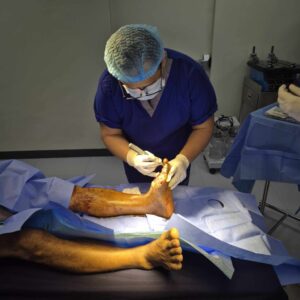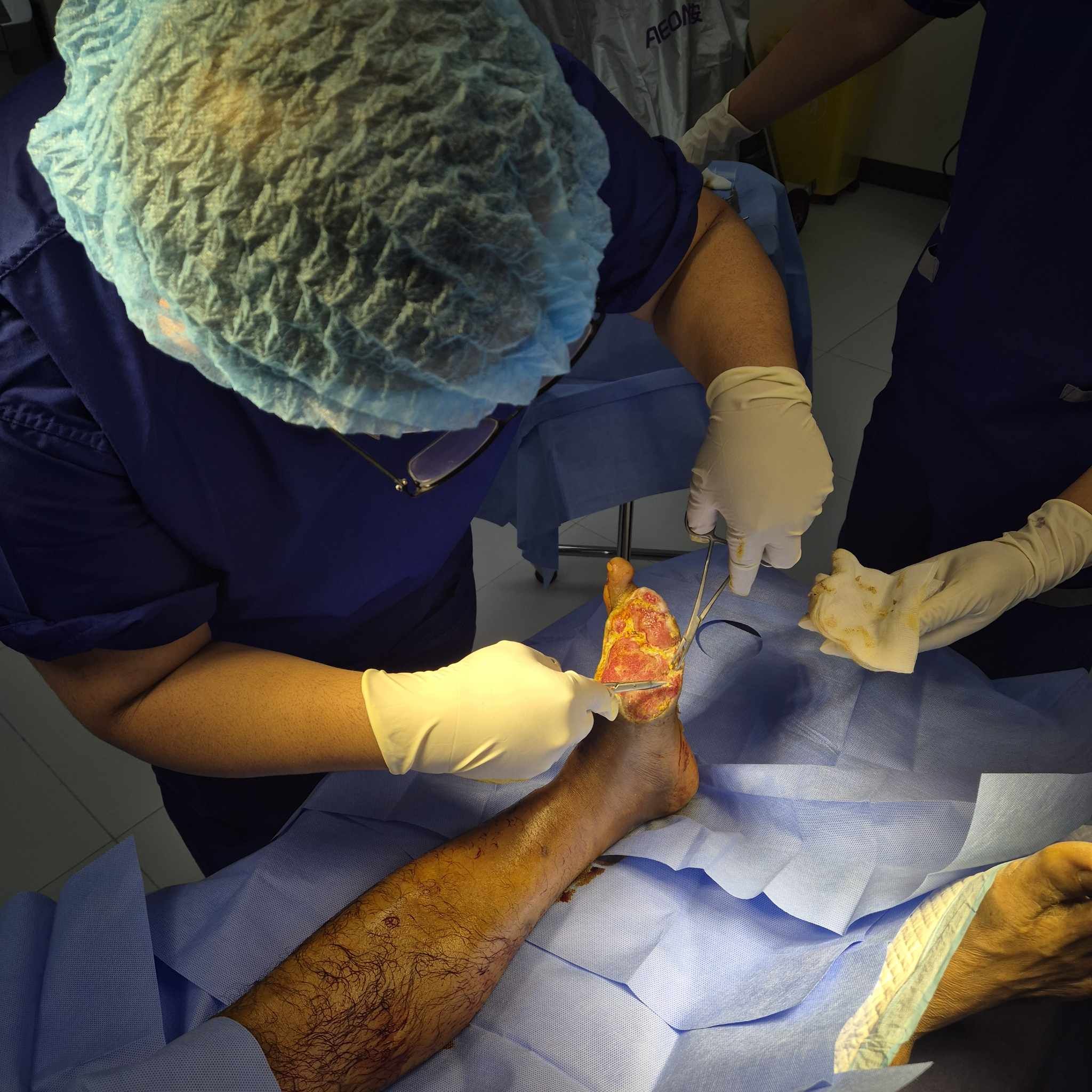Debridement Services play a crucial role whenever a wound struggles to recover due to dead or infected tissue. Proper removal of damaged tissue opens the way for healthier skin growth, lowers the risk of complications, and supports faster recovery. Many patients dealing with chronic wounds, diabetic ulcers, or pressure injuries depend on Debridement Services to restore safer conditions for healing. With modern tools and expert-guided care, this essential procedure offers a structured method for preparing wounds for recovery while preventing deeper complications.
Understanding Debridement Services and Their Purpose
Debridement Services focus on taking out dead, damaged, or infected tissue that prevents a wound from closing properly. When tissue loses blood supply or becomes contaminated, it forms a barrier that slows down healing and often triggers swelling, foul odor, or persistent drainage. Removing this tissue clears out harmful elements and encourages stronger skin regeneration.
Debridement Services also support better penetration of topical treatments and improve the effectiveness of dressings. Without this essential step, even well-managed wounds may fail to respond to regular care. By preparing the wound bed, these services give patients a much higher chance of achieving a complete and timely recovery.
Types of Debridement Services Commonly Provided
Modern wound care professionals offer several approaches, each selected based on the patient’s condition, wound depth, and overall health status. Debridement Services may involve gentle or aggressive methods depending on how much dead tissue must be removed.
Mechanical Debridement
This approach relies on physical force to loosen and remove unwanted tissue. It may use wound irrigation, wet-to-dry dressings, or specialized equipment. Mechanical methods work well for wounds with moderate debris but require careful handling to protect healthy tissue.
Autolytic Debridement
Moisture-retentive dressings allow the body’s natural enzymes to break down unhealthy tissue. Debridement Services that use this method often support comfort and gradual progress. It suits patients with mild necrosis or those who require a gentler approach.
Enzymatic Debridement
Topical agents break apart dead tissue without harming healthy skin. These solutions help patients who cannot undergo surgical options. Debridement Services that include enzymatic preparations often work well for wounds with stubborn slough.
Surgical or Sharp Debridement
A trained professional removes dead tissue quickly and precisely using surgical tools. This option suits severe cases where rapid clearance is essential. Debridement Services involving sharp removal help prepare the wound bed for immediate improvement.
Ultrasonic Debridement
Advanced wound care facilities use low-frequency sound waves to loosen and clear necrotic tissue. This modern approach offers accuracy, comfort, and effective removal with minimal discomfort.
Signs That a Patient May Require Debridement Services
Certain warning signs indicate the need for professional care. Debridement Services become essential when wounds show:
- Thick or blackened tissue
- Persistent slough that covers the wound bed
- Yellow, gray, or leathery areas
- Odor or discharge that suggests bacterial growth
- Chronic wounds that do not respond to standard care
- Diabetic ulcers or pressure sores showing signs of deterioration
- Traumatic wounds that refuse to close
Without prompt intervention, these wounds may worsen, cause severe infections, or lead to deeper complications.
How Debridement Services Support Faster Recovery
The core purpose of Debridement Services is to clear away anything that blocks healing. By removing dead or contaminated tissue, the wound becomes more responsive to dressings and medical treatment. Fresh, healthy tissue receives better oxygen supply, blood flow improves, and the risk of harmful bacteria entering the bloodstream decreases.
Debridement Services help reduce swelling, lower odor, and minimize pressure on sensitive skin. Faster closure becomes possible once the wound bed is properly prepared. Patients with chronic wounds often see significant improvement once this essential step is completed.
Step-by-Step Overview of the Debridement Process
Although the approach may vary based on the selected method, Debridement Services typically follow a structured flow designed for safety and comfort.
Initial Assessment and Wound Evaluation
A wound care professional examines the wound’s depth, size, tissue condition, moisture level, and level of contamination. This assessment determines the safest and most suitable form of debridement.
Preparation and Patient Comfort Measures
Comfort comes first during Debridement Services. The care team assesses pain levels and prepares the patient through topical anesthesia, numbing methods, or guidance for easier management.
Dead Tissue Removal Using the Chosen Method
The professional removes necrotic tissue using mechanical, surgical, enzymatic, autolytic, or ultrasonic techniques. Careful execution ensures healthy tissue remains protected.
Application of Modern Dressings
After the removal, dressings support moisture balance, temperature regulation, and protection from contaminants. Advanced wound dressings help prevent dryness and encourage new cell formation.
Follow-Up Monitoring and Healing Support
Debridement Services include regular monitoring to track healing, adjust treatments, and prevent complications. Continuous follow-up helps ensure the wound moves steadily toward closure.
Who Can Benefit from Professional Debridement Services?
Debridement Services serve a wide range of patients, especially those who struggle with wounds that refuse to recover. Common groups that benefit include:
- Patients with diabetic foot wounds
- Elderly individuals dealing with pressure injuries
- People recovering from major surgery
- Patients with compromised immune systems
- Individuals with traumatic or deep wounds
- Those with vascular disorders affecting blood flow
A professional approach reduces complications, supports long-term recovery, and improves comfort throughout the healing process.
Advantages of Getting Debridement Services from a Specialized Clinic
Specialized wound care clinics offer several advantages for patients needing Debridement Services:
- Access to skilled professionals with extensive wound care knowledge
- Use of modern tools such as ultrasonic systems
- Faster healing through targeted treatment
- Reduced chances of complications
- Clear guidance tailored to each patient
- A safe environment where proper hygiene and monitoring are maintained
These benefits create a smoother healing experience and increase the likelihood of complete tissue recovery.
Aftercare Tips for Patients Following Debridement
Professional debridement lays the foundation for healing, but consistent aftercare ensures continuous progress. Patients who undergo Debridement Services benefit from the following guidelines:
Proper Wound Cleaning at Home
Patients should follow the clinic’s wound cleaning instructions to maintain cleanliness and reduce contamination.
Dressing Replacement Schedules
Regular replacement supports moisture control and shields recovering tissue from dirt and bacteria.
Signs of Infection to Watch For
Redness, unusual discharge, fever, warmth, or swelling may require immediate medical attention.
Footwear and Pressure Relief Advice
For foot wounds, supportive footwear and pressure-relieving methods reduce stress on recovering areas.
Nutrition and Hydration for Better Healing
Healthy meals, vitamins, and proper hydration support stronger tissue formation.
Importance of Follow-Up Visits
Debridement Services work best with continuous monitoring to adjust care as the wound changes.
Choosing the Right Facility for Debridement Services
Selecting a suitable wound care provider makes a major difference. Patients should look for:
- Clinics that offer advanced equipment
- Professionals with strong wound care backgrounds
- Clear communication and patient-centered guidance
- A clean, well-maintained environment
- Services designed for chronic, surgical, and traumatic wounds
Quality matters greatly when seeking Debridement Services, especially for wounds that require specialized attention.
Frequently Asked Questions (FAQ)
Is debridement painful?
Most patients experience manageable discomfort due to preparation steps that support comfort. Modern tools reduce unnecessary pain during Debridement Services.
How long does recovery take after debridement?
Recovery varies based on wound size, patient health, and aftercare consistency. Many patients see gradual improvement shortly after Debridement Services are completed.
Which type of debridement is best for my wound?
A professional assessment determines the safest and most effective method.
Can debridement stop repeated infections?
Proper removal of dead tissue reduces bacterial growth, which helps decrease recurring infections.
How often are Debridement Services required?
Some patients need multiple sessions, especially for chronic or deep wounds. Frequency depends on wound progress.
What should I expect during my first visit?
A full evaluation takes place, followed by a recommendation for the most suitable debridement method.











